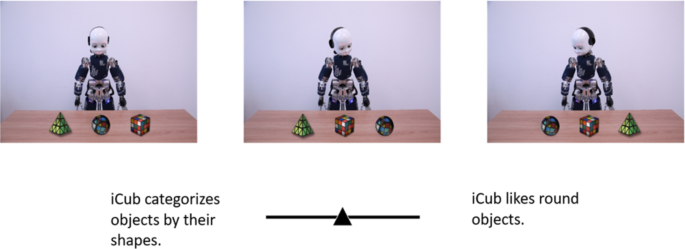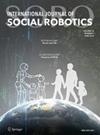教育类型影响个体对机器人的意向姿态:一项脑电图研究
IF 3.8
2区 计算机科学
Q2 ROBOTICS
引用次数: 1
摘要
研究表明,在某些情况下,人们可以对机器人采取有意识的立场,从而将它们视为有意识的代理人。先前的证据表明,有一些因素在调节意向立场,例如个人的受教育年限。在本研究中,我们的目的是调查,给定相同的教育年限,参与者的正规教育类型-就理论背景而言-是否影响他们对意向立场的采用。为了做到这一点,我们招募了两个不同类型正规教育的参与者样本,也就是说,一个样本的参与者包括具有机器人背景的人,而另一个样本的参与者包括具有心理治疗背景的人。为了衡量他们采用意向立场的可能性,我们要求他们完成实例测试(IST)。为了在神经水平上做到这一点,我们通过脑电图(EEG)记录了他们在休息状态下的神经活动。结果表明,治疗师比机器人专家将更高的意向性IST分数归因于机器人,即他们更有可能将有意姿态归因于机器人的行为。这一结果反映在参与者在静息状态下的脑电图神经活动上,因为我们发现与机器人专家相比,治疗师的伽马频率范围(与心智化和有意识姿态的采用有关)的功率更高。因此,我们得出结论,促进心智化技能的教育类型增加了将意向性归因于机器人的可能性。本文章由计算机程序翻译,如有差异,请以英文原文为准。

Type of Education Affects Individuals’ Adoption of Intentional Stance Towards Robots: An EEG Study
Abstract Research has shown that, under certain circumstances, people can adopt the Intentional Stance towards robots and thus treat them as intentional agents. Previous evidence showed that there are factors at play in modulating the Intentional Stance, for example individuals’ years of education. In the present study, we aimed at investigating whether, given the same years of education, participants’ type of formal education- in terms of theoretical background- affected their adoption of the Intentional Stance. To do so, we recruited two samples of participants varying in their type of formal education, namely, a sample of participants comprised individuals with a background in robotics, whereas the other comprised individuals with a background in psychotherapy. To measure their likelihood of adopting the Intentional Stance, we asked them to complete the InStance Test (IST). To do it at the neural level, we recorded their neural activity during a resting state via electroencephalography (EEG). Results showed that therapists attributed higher IST scores of intentionality to the robot than roboticists, i.e., they were more likely to attribute Intentional Stance to explain robot’s behaviour. This result was mirrored by participants’ EEG neural activity during resting state, as we found higher power in the gamma frequency range (associated with mentalizing and the adoption of Intentional Stance) for therapists compared to roboticists. Therefore, we conclude that the type of education that promotes mentalizing skills increases the likelihood of attributing intentionality to robots.
求助全文
通过发布文献求助,成功后即可免费获取论文全文。
去求助
来源期刊

International Journal of Social Robotics
ROBOTICS-
CiteScore
9.80
自引率
8.50%
发文量
95
期刊介绍:
Social Robotics is the study of robots that are able to interact and communicate among themselves, with humans, and with the environment, within the social and cultural structure attached to its role. The journal covers a broad spectrum of topics related to the latest technologies, new research results and developments in the area of social robotics on all levels, from developments in core enabling technologies to system integration, aesthetic design, applications and social implications. It provides a platform for like-minded researchers to present their findings and latest developments in social robotics, covering relevant advances in engineering, computing, arts and social sciences.
The journal publishes original, peer reviewed articles and contributions on innovative ideas and concepts, new discoveries and improvements, as well as novel applications, by leading researchers and developers regarding the latest fundamental advances in the core technologies that form the backbone of social robotics, distinguished developmental projects in the area, as well as seminal works in aesthetic design, ethics and philosophy, studies on social impact and influence, pertaining to social robotics.
 求助内容:
求助内容: 应助结果提醒方式:
应助结果提醒方式:


